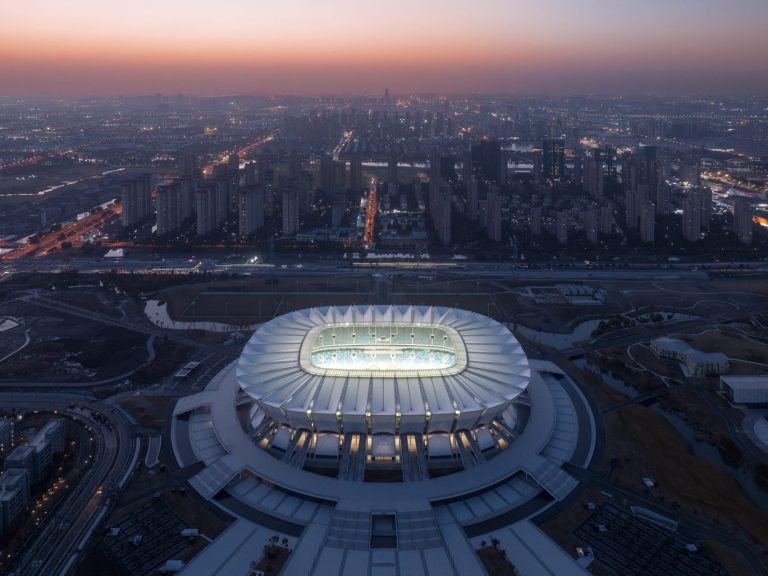Kunshan Olympic Stadium Connects to Park via Elevated Ring
Kunshan Olympic Stadium is redefining stadium architecture by merging urban design with nature, thanks to a clever system of elevated bridges and ramps. Located in Kunshan, China, this 45,000-seat arena is the result of a collaboration between German architectural firm GMP Architekten, engineering specialists Schlaich Bergermann Partner (SBP), and WES LandschaftsArchitektur.
Built on a parkland site threaded by a natural waterway, the stadium avoids displacing nature. Instead, it integrates it. According to GMP partner Magdalena Weiss, the team aimed to preserve the original environment, embedding the structure within the landscape. “We preserved as much of the original environment as possible,” Weiss stated, emphasizing that the stadium’s circular bridge ring functions as both a natural barrier and an efficient visitor circulation system.
Integrated Design Enhances Flow and Sustainability
The core idea behind the Kunshan Olympic Stadium is simplicity and accessibility. Rather than building a deep, vertically stacked complex, architects opted for an open, horizontal layout. The design includes 48 wide staircases and bridges leading from the surrounding podium directly into seating tiers. This allows fans to enter from all directions, improving pedestrian flow and creating a seamless transition between the stadium and the surrounding park.
Read Also
Africa’s Largest Stadium: FNB Stadium Still Holds the Crown
Rwanda’s Tallest Building: Kigali City Tower and the Rise of Kigali Green Complex
The seating design prioritizes both efficiency and ambiance. Commercial facilities such as shops, restaurants, and cafés have been built into a separate outer ring. Visitors can bypass this layer via bridges, which maintains access without forcing interaction.
Structure Reflects Artistic and Environmental Ideals
From a structural perspective, the stadium is a marvel of engineering. It features large double columns of in-situ cast concrete that support steel trusses, which span the roof. Draped in translucent fabric membranes, the roof maintains a light yet durable form. The outward-radiating columns form a fan-like shape, giving the venue its iconic appearance.
Inside, the seating colors—blue, green, and red specks—are inspired by traditional Chinese landscape paintings, reinforcing the connection to the natural world. The structure’s elevation enhances airflow and reduces the need for artificial cooling, aligning with sustainable design goals.
The Kunshan Olympic Stadium demonstrates how sports venues can be environmentally embedded while offering urban accessibility. The design emphasizes geometry, efficient circulation, and sustainable materials, setting a new architectural benchmark in Asia.
Founded in 1965, GMP Architekten is known for its blend of functionality and bold aesthetics. Their latest project continues this tradition, offering a venue that is practical, visually striking, and culturally resonant.
As the stadium opens, it stands not only as an architectural icon, but also as a public green landmark and a symbol of integrated urban planning.

